
- •Introduction
- •Applications of Real-Time Systems
- •Voltage
- •Figure 7: Conversion of an Analog Signal to a 16 bit Binary Number
- •Figure 11: Schematic Representation of tmr
- •It is relatively simple to design a hardware equipment to be fault-tolerant. The following are two methods that are popularly used to achieve hardware fault-tolerance:
- •Software Fault-Tolerance Techniques
- •Types of Real-Time Tasks
- •Timing Constraints
- •Events in a Real-Time System
- •Figure 16: Delay Constraint Between Two Events el and e2
- •Examples of Different Types of Timing Constraints
- •Figure 19: Classification of Timing Constraints
- •Real-Time Task Scheduling
- •Figure 1: Relative and Absolute Deadlines of a Task
- •Figure 2: Precedence Relation Among Tasks
- •Types of Real-Time Tasks and Their Characteristics
- •Classification of Real-Time Task Scheduling Algorithms
- •Figure 5: An Example Schedule Table for a Cyclic Scheduler
- •Figure 6: Major and Minor Cycles in a Cyclic Scheduler
- •Comparison of Cyclic with Table-Driven Scheduling
- •Hybrid Schedulers
- •Event-driven Scheduling
- •Is edf Really a Dynamic Priority Scheduling Algorithm?
- •Implementation of edf
- •Figure 10: Priority Assignment to Tasks in rma
- •We now illustrate the applicability of the rma schodulability criteria through a few examples.
- •Deadline Monotonic Algorithm (dma)
- •Handling Aperiodic and Sporadic Tasks
- •Dealing With Task Jitter
- •W Good real-time task scheduling algorithms ensure fairness to real-time tasks while scheduling.
- •State whether the following assertions are True or False. Write one or two sentences to justify your choice in each case.
- •Figure 2: Unbounded Priority Inversion
- •Highest Locker Protocol(hlp)
- •Priority Ceiling Protocol (pcp)
- •Comparison of Resource Sharing Protocols
- •Handling Task Dependencies
- •Fault-Tolerant Scheduling of Tasks
- •Clocks in Distributed Real-Time Systems
- •Clock Synchronization
- •Figure 1: Centralized synchronization system
- •Cn Slave clocks
- •Commercial Real-Time Operating Systems
- •Time Services
- •Clock Interrupt Processing
- •Providing High Clock Resolution
- •Figure 2: Use of a Watchdog Tinier
- •Unix as a Real-Time Operating System
- •In Unix, dynamic priority computations cause I/o intensive tasks to migrate to higher and higher priority levels, whereas cpu-intensive tasks are made to seek lower priority levels.
- •Host-Target Approach
- •Preemption Point Approach
- •Self-Host Systems
- •Windows As a Real-Time Operating System
- •Figure 9: Task Priorities in Windows nt
- •Open Software
- •Genesis of posix
- •Overview of posix
- •Real-Time posix Standard
- •Rt Linux
- •7.8 Windows ce
- •Benchmarking Real-Time Systems
- •Figure 13: Task Switching Time Among Equal Priority Tasks
- •Real-Time Communication
- •Figure 2: a Bus Architecture
- •Figure 4: Logical Ring in a Token Bus
- •Soft Real-Time Communication in a lan
- •Figure 6: Priority Arbitration Example
- •Figure 8: Problem in Virtual Time Protocol
- •Figure 9: Structure of a Token in ieee 802.5
- •Figure 10: Frames in the Window-based Protocol
- •Performance Comparison
- •A Basic Service Model
- •Traffic Characterization
- •Figure 16: Constant Bit-Rato Traffic
- •Routing Algorithms
- •Resource Reservation
- •Resource Reservation Protocol (rsvp)
- •Traffic Shaping and Policing
- •Traffic Distortion
- •Traffic Scheduling Disciplines
- •Figure 20: Packet Service in Jittor-edd
- •Differentiated Services
- •Functional Elements of DiffServ Architecture
- •Real Time Databases
- •Isolation: Transactions are executed concurrently as long as they do not interfere in each other’s computations.
- •Real-Time Databases
- •Real-Time Database Application Design Issues
- •Temporal Consistency
- •Concurrency Control in Real-Time Databases
- •It can bo shown that pcp is doadlock froo and single blocking. Rocolloct that single blocking moans that once a transaction starts executing after being blocked, it may not block again.
- •Speculative Concurrency Control
- •Comparison of Concurrency Control Protocols
- •Commercial Real-Time Databases
- •Figure 16: Uniform Priority Assignment to Tasks of Example 15
- •Version 2 cse, iit Kharagpur
Figure 13: Task Switching Time Among Equal Priority Tasks
Task switching time is defined as the time it takes for one context switch among equal priority tasks. Consider the example shown in Fig. 5.13. Assume that Т^Т^Тз are equal priority tasks and that round robin option among equal priority tasks is supported by the scheduler. In Fig. 5.13, tts is the time after which T2 starts to execute after T± completes its time slice, blocks, or completes (tts = i2 — ti). Task switching time is determined by the efficiency of the kernel data structure.
Task Preemption Time (). Task preemption time is defined as the time it takes to start execution of a higher priority task (compared to the currently running task), after the condition enabling the task occurs. Task preemption time has been illustrated in the example shown in Fig. 14. Task preemption time consists of the following three components: task switching time tts, time to recognize the event enabling the higher priority, and the time to dispatch it. Clearly, task preemption time would be normally larger than task switching time.
Interrupt Latency Time (tu). Interrupt latency time is defined as the time it takes to start the execution of
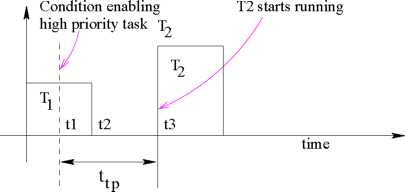
Figure
14: Task Preemption Time
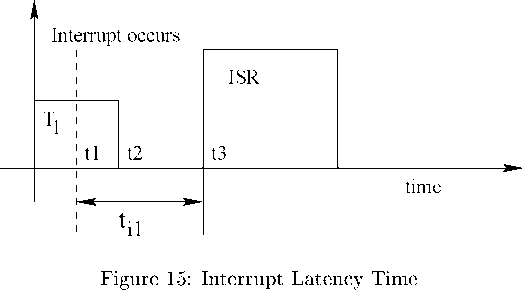
the required ISR after an interrupt occurs. Interrupt latency time for an example has been shown in Fig. 15. Interrupt latency time consists of the following components: hardware delay in CPU recognizing the interrupt, time to complete the current instruction, time to save the context of the currently running task, and then to start the ISR.
Semaphore Shuffling Time (tss). Semaphore shuffling time is defined as the time that elapses between a
Release
Semaphore
Acquire
Semaphore
Request
Semaphore
Figure
16: Semaphore Shuffling Time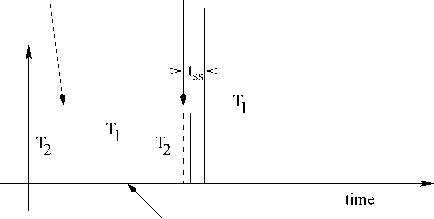
lower priority task releasing a semaphore and a higher priority task to start running. Semaphore shuffling time has been illustrated in Fig. 5.16. In Fig. 5.16, at a certain time task T? holds the semaphore. The task T± requests for the semaphore and blocks. The interval between T± returning the semaphore and T? running is known as the semaphore shuffling time.
Unbounded Priority Inversion Time (tup). As shown in figure 17, unbounded priority inversion time tup
Figure
17: Unbounded Priority Inversion Time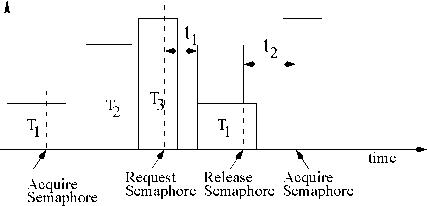
is computed as the time it takes for the operating system to recognize priority inversion (fi) and run the task holding the resource and start T2 after T± completes (t2). Symbolically, tup = t± + t?-
Datagram Throughput Time (1,ц). This parameter indicates the number of kilobytes of data that can be transfered between two tasks without using shared memory or pointers. This parameter measures the efficiency of the data structures handling message passing primitives.
The Rhealstone metric is computed as a weighted average of the identified parameters:
Rhealstone Metric = a± * tts + «2 * ttp + (13 * tu + (14 * tss + a$ * tup + a§ * tjt Where, al, ..., a6 are empirically determined constants.
Rhealstone benchmark’s figure of merit characterizes the kernel-hardware combination of a system. This is therefore a comprehensive benchmark. However, Rhealstone has some serious drawbacks. First, the ability to meet deadlines of applications (task scheduling etc.) is not considered at all. Also, the six measurement categories are somewhat ad-hoc and there is no proper justification as why only these six measurements have been chosen.
Interrupt Processing Overhead
Let to be the time to complete a certain task when there are no interrupts and let t2o,ooo be the time to complete the same task when 20,000 interrupts occur per second. Then the overhead due to 20,000 interrupts per second is given by:
T ho, 000 — to
^20,000 — 7
4
Consider for example that t2o,ooo is 1-6 sec and to is 1 sec. Then, the interrupt processing overhead /20,000 is 0.6 (or 60%) of the task execution time. The overhead considered is only for processing the immediate part of the interrupts and not the deferred parts.
Tridimensional Measure
Tridimensional measure considers three factors that affect the performance of a real-time system. These identified parameters are: Millions of Instructions Processed per Second (MIPS1), Millions of Interrupts Processed per Second (MIPS2), Number of I/O Operations Per Second (NIOPS). Once these three parameters have been determined, the tridimensional measure (TM) can be obtained by using the following expression:
TM = (MIPS! * MIPS2 * NIOPS)*
Determining Kernel Preemptability
Some times it becomes necessary to determine the extent to which an operating system kernel is preemptible by higher priority real-time tasks. Fig. 18 shows an experimental set up that can indicate kernel preemptability. In Fig.
the TRIANG module generates random triplets denoting three vertices of a triangle. There are n real-time tasks RT±, ...RTn which read the triangle vertices and carry out certain processing and finally output the original triangle vertices to the analyzer module through message passing. TRIANG operates at higher priorities than real-time tasks. The timer first invokes TRIANG, and then invokes a system call such as process creation, and subsequently triggers a different real-time task ( RT±, ...RTn) each time. The analyzer compares the triangle vertices received from the TRIANG and from the real-time task. If the system kernel is not preemptable, then even before the real-time task can read the triangle value, the next set of triangle values over writes the last generated values. The timer frequencies are varied and the analyzer results are observed. The timer frequency at which vertices get missed (as identified by the analyzer), indicates the worst case kernel preemption time.
Figure
18: Setup for TRIANG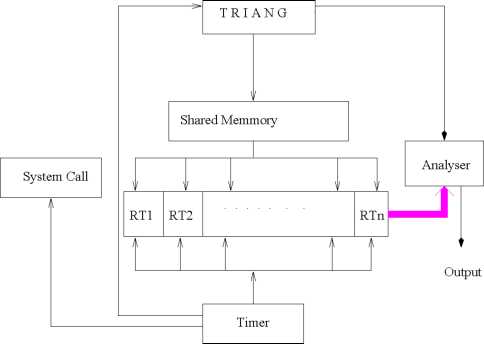
SUMMARY
We first discussed the basic features that any real-time operating system is required to support. Some of the important features required of a real-time operating system, if it is to be used for hard real-time applications are: high resolution clock and timer services, static priority levels, low task preemption times (of the order of a few microseconds), low interrupt latency time, low jitter in memory access, and support for resource sharing among real-time tasks.
We explained why traditional operating systems such as Unix and Windows are not suitable for hard real-time applications. We pointed out that the main problems that a programmer would face while developing a realtime application using Unix are dynamic priority levels and non-preemptable kernel. Though Windows NT sports many positive features for real-time programming, the way Windows NT handles interrupts might result in unbounded response times for real-time tasks.
We surveyed the important features of some of the commercially used real-time operating systems. We discussed why free real-time operating systems such as RTLinux, /xCOS, and Lynx are gaining ground.
We highlighted the parameters based on which the performance of real-time systems can be benchmarked.
EXERCISES
28
State whether you consider the following statements to be TRUE or FALSE. Justify your answer in each
CclSG.
In real-time Linux (RTLinux), real-time processes are scheduled at priorities higher than the kernel processes.
EDF scheduling of tasks is commonly supported in commercial real-time operating systems such as PSOS and VRTX.
POSIX 1003.4 (real-time standard) requires that real-time processes be scheduled at priorities higher than kernel processes.
Under the Unix operating system, computation intensive tasks dynamically gravitate to higher priorities.
When PCP (priority ceiling protocol) is implemented in Windows NT by an application programmer, any real-time priority levels can be assigned to tasks and ceiling values computed on these to implement PCP.
Normally, task switching time is larger than task preemption time.
Between segmented and virtual addressing schemes, the segmented addressing scheme would in general incur lower jitter in memory access compared to the virtual addressing scheme.
POSIX is an attempt by ANSI/IEEE to enable executable files to be portable across different Unix machines.
If FIFO scheduling among equal priority tasks is not supported by an operating system, then in an implementation of priority ceiling protocol (PCP) at the user-level, only half of the available priority levels can meaningfully be assigned to the tasks.
(j) Suppose a real-time operating system does not support memory protection, then a procedure call and a system call are indistinguishable in that system.
(k) Watch dog timers are typically used to start sensor and actuator processing tasks at regular intervals.
For memory of same size under segmented and virtual addressing schemes, the segmented addressing scheme would in general incur lower memory access jitter compared to the virtual addressing scheme.
(m) For faster response time, an embedded real-time operating system needs to be run from a ROM rather than a RAM.
Even though clock frequency of modern processors is of the order of several GHz, why do many modern realtime operating systems not support nanosecond or even microsecond resolution clocks? Is it at all possible for an operating system to support nanosecond resolution clocks at present? Explain how this can be achieved?
Give an example of a real-time application for which a simple segmented memory management support by the RTOS is preferred and another example of an application for which virtual memory management support is essential. Justify your choices.
Is it possible to meet the service requirements of hard real-time applications by writing additional layers over the Unix System V kernel? If your answer is “no”, explain why not? If your answer is “yes”, explain what additional features would you implement in the external layer of Unix System V kernel for supporting hard real-time applications?
As the developer of hard real-time applications, explain some of the features that you would require a real-time operating system (RTOS) to support.
Briefly indicate how Unix dynamically recomputes task priority values. Why is such recomputation of task priorities required? What are the implications of such priority recomputations on real-time application development?
What is the difference between synchronous I/O and asynchronous I/O? What are the implications of these two types of I/O for real-time applications.
Explain the pros and cons of supporting virtual memory in embedded real-time applications.
What do you understand by memory protection in operating system parlance. Compare the pros and cons of requiring an embedded real-time operating system (RTOS) to support memory protection?
What is the difference between block I/O and character I/O? For each type of I/O, give an example of a task that needs to use it. Which type of I/O is accorded higher priority by Unix? Why?
Why is Unix V non-preemptive in kernel mode? How do fully preemptive kernels based on Unix (e.g. Linux) overcome this problem? Briefly describe an experimental set up that can be used to determine the preemptability of different operating systems by high-priority real-time tasks when a low priority task has made a system call.
Suppose that you have to select a suitable computer for a process control application, out of several available computers. Write four important performance parameters which you would consider in benchmarking real-time computer systems. Define these parameters and explain why they are important in real-time applications.
Explain the time services that a real-time operating system (RTOS) is expected to support. Also, briefly highlight how such timer services are implemented in a real-time operating system.
What is an open system? What are its advantages compared to a closed system?
What is a watchdog timer? Explain the use of a watchdog timer using an example.
List four important features that a POSIX 1003.4 (Real-Time standard) compliant operating system must support. Is preemptability of kernel processes required by POSIX 1003.4? Can a Unix-based operating system using the proomption-point technique claim to be POSIX 1003.4 compliant? Explain your answers.
Suppose you are the manufacturer of small embedded components used mainly in consumer electronics goods such as automobiles, MP3 players, and computer-based toys. Would you prefer to use PSOS, WinCE, or RT-Linux in your embedded component? Explain the reasons behind your answer.
Explain how interrupts are handled in Windows NT. Explain how the interrupt processing scheme of Windows NT makes it unsuitable for hard real-time applications. How has this problem been overcome in WinCE?
Windows NT does not provide any support to synchronize access of tasks to critical resources. Explain how resource sharing among tasks can be supported.
Would you recommend Unix System V to be used for a few real-time tasks for running a data acquisition application? Assume that the computation time for these tasks is of the order of few hundreds of milliseconds and the deadline of these tasks is of the order of several tens of seconds. Justify your answer.
Explain the problems that you would encounter, if you try to develop and run a hard real-time application on the Windows NT operating system.
How is the integrity of the kernel data structure preserved in Unix V in the face of preemptions of the kernel by interrupts and higher priority real-time tasks? Why does this technique not work successfully in preserving the integrity of the kernel data structures in multiprocessor implementations? Very briefly explain the important approaches that have been adopted to overcome this problem of making Unix-based systems suitable for realtime application development.
Briefly explain why the traditional Unix kernel is not suitable to be used in a multiprocessor environment. Explain a spin lock and a kernel-level lock and discuss their use in realizing a preemptive kernel.
What do you understand by a microkernel-based operating system? Explain the advantages of a microkernel- based real-time operating system over a monolithic operating system in supporting real-time applications.
What is tho difforonco botwoon a microkornol-basod roal-timo oporating systom and a dual kornol roal-timo oporating systom. Givo an oxamplo of oach. Comparo tho pros and cons of tho two approaches to dovoloping a roal-timo oporating systom.
What is a roal-timo filo systom? What additional foaturos doos a roal-timo filo systom support compared to traditional filo systems? Why is use of a real-time file system essential in hard real-time applications?
What is tho difforonco botwoon a systom call and a function call? What problems, if any, might arise if tho systom calls are indistinguishable from procedure calls?
Explain how a roal-timo oporating systom differs from a traditional oporating systom. Name a few roal-timo oporating systems that are commercially available.
What is tho difforonco botwoon a solf-host and a host-target based embedded oporating systom? Givo at least one oxamplo of a commercial commercial oporating systom from oach category. What problems would an roal-timo application developer might face while using RT-Linux for dovoloping hard roal-timo applications?
What is an open software? Doos an open software mandate portability of tho executable files across different platforms? Name an open software standard for roal-timo oporating systems. What is tho advantage of using an open software oporating systom for roal-timo application development?
What are tho important foaturos doos a roal-timo application developer expect from a roal-timo oporating systom? Analyze to what extent are those foaturos provided by Windows NT and Unix V.
What do you understand by a host-target typo of roal-timo oporating systom? Givo two commercial examples of host-target typo of roal-timo oporating systom. Explain tho architecture of such an oporating systom and also explain how a roal-timo application can bo developed on a host-target typo of oporating systom.
Identify at least four important advantages of using VxWorks as tho oporating systom for largo hard roal-timo applications compared to using Unix V.3.
What is an open software? What are the pros and cons of using an open software product in program development, compared to using an equivalent proprietary product?
What is an open source standard? How is it different from open object and open binary standards? Givo somo examples of popular open source software products.
Can multithreading result in faster response times (compared to single threaded tasks) oven in uniprocessor systems? Explain your answer and identify tho reasons to support your answer.
Explain why traditional (non-roal-timo) oporating systems need to dynamically change tho priority levels of tasks. What is the implication of this for real-time application development using such an operating system.
References
Hennossy John L. and David A. Patterson. Computer Architecture — A Quantitative Approach. Morgan Kauf- rnann Publishers, 2003.
Kar R.P. and Porter K. Rhealstone - a real-time benchmarking proposal. Dr. Dobb’s Journal, February 1989.
Brian Santo. Embedded battle royalo. IEEE Spectrum,, pages 36-42, December 2001.
